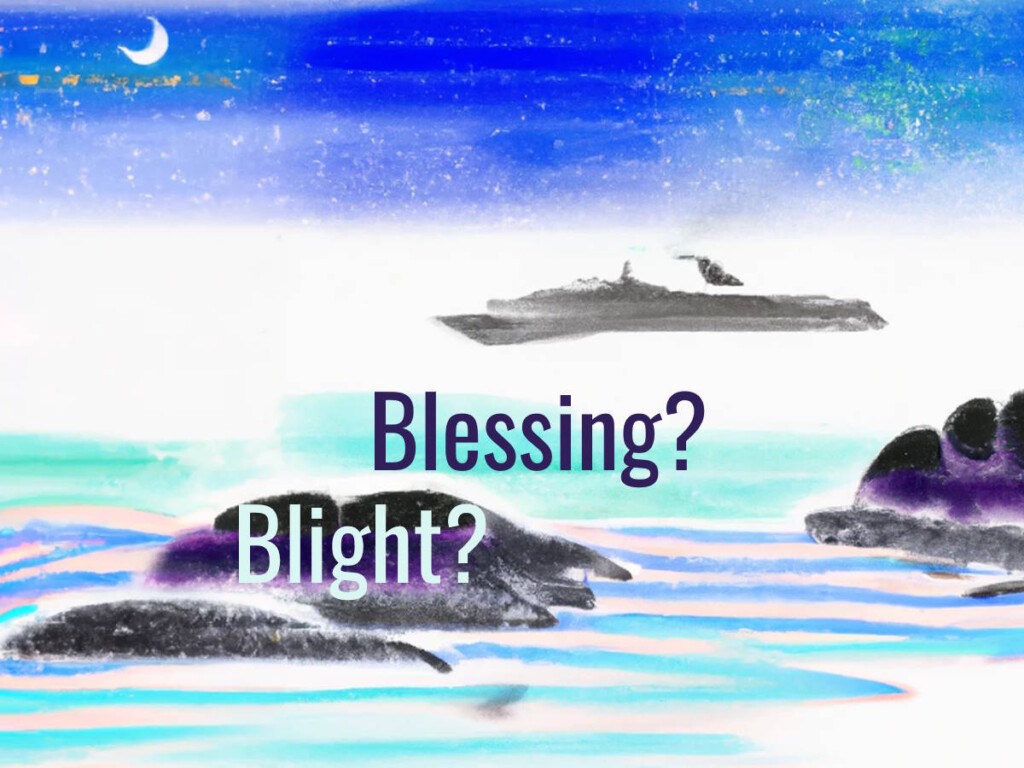Cruise ships: Blessing or blight?

Are cruise ships a blessing or a blight?
Why?
Your correspondent put these simple questions about cruise ships to “GT’s” diverse network of travel & tourism stakeholders — “GT” Insight authors, “GT” Partners, and their invitees — and requested written responses of no more than 300 words.
Click/touch a name to go to their answer:
- Saverio F Bertolucci — A blight for residents. A blessing for travellers.
- Zohreh Khosravi — ‘Cruising has nothing in common with sustainable tourism’
- Greg Bakunzi — Value, fun, socialisation, and economic benefits
- Susan Eardly — Can a blight be turned into a blessing?
- Herb Hiller — ‘We can’t afford to remain ignorant about what we must protect’
- Steve Noakes — The good, the bad, and the ugly
- Jim Butcher — ‘Faux radical critique’ and ‘condescension’ undeserved
- Dominic Standish — Cruising has been unfairly demonised but can be improved
- Richard A Shepard — ‘Cruise ships are not going away, but they should’
- ChatGPT — The debate is ‘multifaceted’
- [Added May 13, 2023] Bard [Experiment] — It’s a personal decision
- What do you think?
Previous “GT” Insight Bites:
- Tourist vs traveller: What’s the difference?
- The heads of finance, operations, and PR walk into their boss’s office …
- Yes, Tourism Minister
- What are tourism’s biggest challenges & threats over the next five years?
- ‘Tourism is built on the backbone of white supremacy’. What do you think?
- Really, what’s the difference? ‘Sustainable tourism’ vs ‘regenerative tourism’
- Want a career in tourism? Important things you should know
- Diverse perspectives on travel & tourism and a fairer world
- Diverse perspectives on economic degrowth and tourism
- Diverse perspectives on visitor dispersion
A blight for residents. A blessing for travellers.
Saverio Francesco Bertolucci, Administrative Assistant, Alcambarcelona, Spain
Cruises are in most cases a blight for residents and a blessing for travellers who are fond of all-inclusive offers.
In the case of small towns like Venice or rural emerging destinations like the Faroe Islands, cruises dock for hours in a port.
In these tiny places, tourists visit nearby areas, usually in big groups of people who overwhelmingly disturb the normal context in which the inhabitants are embedded.
A few of them buy goods but none buy services since they are all offered by the cruise company, so the net impact on society and the local perception of cruises are deeply negative.
The most damaging side is, therefore, related to the attitude tourists have during their stay.
The majority of cruise customers are baby boomers who embrace capitalism and do not correctly plunge into the society and culture of the destination, creating a clear boundary between guest and host.
In the case of uninhabited lands, however, tourists have a limited impact. International environmental laws clearly regulate their actions and movements.
Indeed, Arctic and Antarctic tourism is becoming a new interesting topic of the hospitality industry, although there are still very few studies.
This is surely a topic worth discussing and studying!
‘Cruising has nothing in common with sustainable tourism’
Zohreh Khosravi, content strategist, Iran
As someone whose field of study is responsible tourism (ecotourism), the first thing that came to my mind when asked this question about cruise ships was their carbon footprint and waste management practices.
Cruising has nothing in common with sustainable tourism. It is more of a luxury ego-tourism activity that attracts a specific type of traveller.
I searched for more information about cruise ships.
The cruise sector is growing at the quickest rate among all forms of tourism. It is anticipated that demand and the associated revenues will rise to be even higher than it was before COVID-19.
The cruise industry has pledged to deploy ships with emission-free fuels by 2030 and to achieve net-zero by 2050.
However, environmental activists don’t believe that the cruise industry will live up to this. They think that cruise will revert to emitting greenhouse gases, polluting the water, and inflicting overtourism and other negative impacts on coastal host communities.
The carbon footprint of a cruise ship is believed to be bigger than that of 12,000 cars. Passengers on an Antarctica cruise are said to emit as much CO2 during the course of a seven-day journey as an average European would over an entire year.
The cruise industry is also one of the largest waste generators. A large cruise ship produces more than one ton of waste per day.
Even if it accomplishes its claims, pollution will be produced for another seven years (until 2030), and its carbon footprint will remain for 27 more years (until 2050).
So, is it a blessing?
Value, fun, socialisation, and economic benefits
Greg Bakunzi, Founder, Red Rocks Initiative for Sustainable Development & Red Rocks Rwanda
As you are aware, Rwanda is a landlocked country.
Recently the only cruise ship launched on Rwanda’s Lake Kivu is the Mantis Kivu Queen uBuranga.
I perceive cruise ships as a blessing as they offer great value for your vacation. Fares include nearly everything you will need for a fantastic trip: food, accommodations, daytime and evening entertainment, and transportation between destinations.
Secondly, they are family-friendly and offer fun for all ages; a great way to socialise and make new friends.
Last, but not least, they offer employment opportunities to people; not only on the ships but on the shores where cruise ships dock. They provide economic benefit to the country and its citizens.
Can a blight be turned into a blessing?
Susan Eardly, Founder, Serene Vacations, Sri Lanka
Cruise ships make for a unique adventure, with accommodation, meals, and entertainment all included. And, at an affordable price, travellers get to see multiple countries.
The demand for cruising has increased, and it will continue to grow in 2023.
Are cruises good for the ocean? Sadly, much marine wildlife is harmed by cruise ships. Cruise ships take a major toll on the environment, so they are a blight in this context.
Research data shows that cruise ships and other maritime vessels are responsible for nearly 3% of global greenhouse emissions each year and 6% of black carbon emissions.
They dump toxic waste into the waters, fill the atmosphere with carbon dioxide, and harm marine wildlife.
Despite many tourists being aware of these harms, and the planetary crossroads we find ourselves at, the cruise industry continues to grow.
Fortunately, the cruise industry is now making positive changes to limit its pollution and waste, such as recycling glass, cans, and paper; reusing bed linens and towels; using more efficient technologies; and providing environmental training for crew members.
A collaborative approach is important. For example, passengers should take responsibility for their own consumption and waste management while on board.
Liners are now designing and implementing exhaust cleaning systems to reduce carbon emissions. They are also tapping solar and wind for renewable power sources.
With the need for a greener, cleaner, and more sustainable fuel source, cruise lines are turning to liquefied natural gas-based ships to reduce greenhouse gas emissions.
With the industry taking steps toward a more environmentally-friendly future to serve more eco-conscious passengers, hopefully cruising can be turned into a blessing.
‘We can’t afford to remain ignorant about what we must protect’
Herb Hiller, Writer, The Climate Traveler, USA
In our epoch of climate change, when we extend hospitality to passengers on cruise ships we become stewards for their behaviour while with us.
That means more than keeping drunks from falling overboard. We become responsible for their entire effect on the waters that our hospitality extends across.
Ships at sea, like aeroplanes in the sky, and hotels ashore — the great integers of tourism — warrant thumbs-up to the extent that they draw down greenhouse gases.
That means, among other things, a deep accounting for waste; not only the recycling or storage of refuse, but also the opportunity cost (waste) of failing to educate passengers on protecting the seas that make their voyages possible.
- Education has to start with a history of humans at sea; the importance of clear horizons by day and dark skies at night for the earliest navigators.
- Education on the importance of the creatures that the oceans sustain and the foods they supply, whose evolution recalls our own emergence from briny waters.
- Education, also, about how ships as long as three football fields and carrying three thousand people remain buoyant while pocket change lost overboard sinks.
We can’t afford to remain ignorant about what we must protect.
The good news is that expedition ships, which directly descend from human discovery and exploration, are leading our way.
Also, barely beyond our awareness, is the emergence of fleets of cruise-ferries that combine limited onboard service for transportation (think around coastal Europe) as well as a range of comforts for overnight passengers cruising between ports of call.
Some 250 cruise-ferries already operate today. They are smaller and quicker to build than cruise ships and may be quicker to adopt climate technology.
Imagine the cross-cultural learning that already takes place between these two distinct passenger sets.
The good, the bad, and the ugly
Steve Noakes, Chair, Binna Burra Lodge, Australia; Founder, Pacific Asia Tourism
My first thoughts about the global cruise ship industry are about the good, the bad, and the ugly.
The cruise is a form of holiday that appeals to many millions of people around the planet, while others have no desire whatsoever to be in such a confined space with thousands of others, especially since the experience of the COVID-19 pandemic.
There are those quality cruise ship operators who provide a service that meets or exceeds the demands and expectations of their target customers, use more clean energy sources, and make a big effort to contribute more to the local communities at their ports of call.
The bad, and sometimes the ugly, relate to a range of issues, such as the cruise industry’s carbon footprint; threats to coastal and marine ecosystems; risks to the public health of coastal communities, passengers, and crew; economic leakage; tax avoidance; and overtourism.
Many reports indicate that cruise ships’ environmental impact is never ending, and they continue to get bigger.
Are customers’ short term gratification and the annual profit motive of the large cruise companies contributing to longer term harm?
The mega cruise ships of the world are not going away.
Maybe it’s a case of preventing the bad from getting worse.
‘Faux radical critique’ and ‘condescension’ undeserved
Jim Butcher, Reader, Canterbury Christ Church University, UK; Tourism’s Horizon; Politics of Tourism
Recently I’ve read denunciations of cruise ships as “monstrosities”, “climate catastrophes” and “icons of idiocy”.
COVID-19 hit the sector hard.
Some were keen to speculate about the end of cruise ships, and were disinclined to mourn their demise. For one commentator this “dystopian” industry is a “lavish world on the brink of collapse” characterised by “vulgar displays of opulence”.
Contrast this with the 1967 launch of the Queen Elizabeth 2 ship at the Glasgow shipyards.
The mood was celebratory, even amongst the militant Red Clydeside shipyard workers. They could take pride in a magnificent example of human ingenuity — the fruit of their labours and skills — and at the same time hold deep criticisms of their employers and the political system.
The problem with these ships was less the opulent luxury, and more that enjoying it was beyond the wage packet of the workers.
With economic development, many more ordinary people can afford a cruise holiday. And they are popular, not least with elderly people who want to see the world in the most relaxing and luxurious way.
What’s not to like?
Quite a lot, apparently.
Cruise ships have become the bête noir of a new breed of holiday Malthusians, one incredulous that cruise passengers could believe they are ‘getting away from it all’ whilst experiencing a population density higher than a Mumbai slum.
Of course cruise ships present their share of problems as well as advantages. Decarbonising, and generally cleaning up their act, are priorities. They draw on a global market of cheap labour, a problem afflicting the service sector generally. But creative planning and technological solutions are a better option than condemnation.
So cruise ships are a blessing, not a blight. The faux radical critique of convivial luxury, along with the condescension their clientele sometimes receive, is undeserved.
In Venice, cruising has been unfairly demonised but can be improved
Dominic Standish, Lecturer, University of Iowa, USA; author based in Veneto, Italy
Cruise ships have been banned from navigating through the centre of Venice since August 1, 2021.
Is this because they are dangerous?
The ban came two years after a cruise ship crash in Venice in 2019 that injured five people. Yet the safety record of cruise ships in Venice is better than other water vessels.
People have died in Venice as the result of speed boat and gondola crashes during the last decade. No one has died in Venice from cruise ship crashes.
Indeed, cruise ships were usually attached to tugs with chains to be pulled for tricky manoeuvres through the centre of Venice. Pilots from local authorities who know the lagoon’s channels well joined cruise ships to guide them.
This makes an accident like the tragic Costa Concordia cruise ship crash off the coast of Tuscany in 2012 unlikely. That crash was due to errors by the captain, who was jailed for causing the accident and manslaughter.
Is the ban due to pollution?
Despite recent efforts to reduce pollution from cruise ships, they have undoubtedly caused fuel and noise pollution. However, journeys by thousands of vessels in Venice every day also pollute and create damaging waves.
Cruise ships generate waves too, but also wakes that have many negative impacts on the lagoon. Nevertheless, other large ships create similar wakes.
I welcome proposals to construct a port for cruise ships and other large vessels outside the lagoon on the Lido or offshore. Passengers and cargo could be transferred to smaller vessels or, preferably, underwater trains linked to Venice.
Modernising cruising infrastructure in Venice and elsewhere would be hugely beneficial.
‘Cruise ships are not going away, but they should’
Richard A Shepard, Trustee & CEO, Sustainable Rural Development International, UK
Cruise ships are not going away, but they should.

I hate 100,000+ ton, 15-storey cruise ships. They are giant milk-cartons that pollute, can be dangerous, and are boring.
I cannot imagine being trapped with thousands of (well-meaning) passengers for days, weeks, or more.
But that’s personal.
More to the point is that these ships leave a carbon footprint the size of the moon. They dump grey water that causes oxygen depletion, spreads pathogenic bacteria and viruses, and increases nutrient levels that lead to toxic blooms and dead zones.
When the industry was told to clean up its air pollution they didn’t use cleaner fuels. They installed scrubbers. It’s cheaper.
Scrubbers use seawater to scrub sulphur dioxide in an open-loop system. Rather than holding waste in a tank to be disposed of at dedicated port facilities, ships directly dump the wastewater — 100,000 times more acidic than seawater — overboard. Every year about 10 gigatonnes (that’s 10 with nine zeros) are dumped into the ocean.
After COVID, if anything should have changed for good, it’s cruise ships and the voracious industry that operates them. This is an industry that co-opts communities, buys up entire waterfronts — sometimes private islands — and takes a significant percentage of every shore excursion sold, leaving scraps for vendors.
The deputy mayor of Barcelona has said: “You will be walking and all of a sudden there’s this mass of people who appear together in the street […] They don’t consume anything and they don’t have an economic impact […] They just wander for four or five hours and leave.” Like locusts.
I could go on for pages.
The next cruise I take will repeat one I took along the Turkish coast on a gullet that holds a maximum of 12 passengers and serves meals with ingredients bought locally.
The debate is ‘multifaceted’
ChatGPT Mar 23 Version
Cruise ships are a polarising topic, with arguments on both sides of the spectrum.

Supporters argue that they are a blessing, bringing economic benefits to local economies, creating jobs, and providing opportunities for travel and cultural exchange.
Cruise ships are often equipped with environmental and safety measures, such as wastewater treatment systems and safety drills, to minimise their impact on the environment and ensure the safety of their passengers and crew.
However, critics see cruise ships as a blight due to their significant environmental, social, and cultural impacts.
Environmental concerns include air and water pollution, carbon emissions contributing to climate change, and large amounts of waste, including sewage and plastic pollution.
Cruise ships can also overwhelm local destinations, causing issues like overcrowding, congestion, and strain on local resources and infrastructure.
Furthermore, labour practices on cruise ships, including low wages, long working hours, and poor working conditions for crew members, have been criticised.
In addition, some argue that cruise ships promote a superficial and disconnected form of tourism, where passengers have brief, superficial interactions with local communities and do not contribute to the long-term sustainability of local economies.
There are concerns that cruise ships can homogenise local cultures, promoting a standardised and commercialised version of destinations that caters to the preferences of a global tourist market.
In conclusion, the debate on whether cruise ships are a blessing or a blight is multifaceted. While they bring economic benefits and travel opportunities, they also have significant environmental, social, and cultural impacts.
It is crucial for the cruise industry, local communities, and policymakers to work together to find a balance and adopt sustainable and responsible practices to mitigate the negative effects of cruise ships.
This includes addressing environmental concerns, labour practices, and promoting authentic and responsible tourism that respects local communities and cultures.
It’s a personal decision
Bard [Experiment]
Cruise ships are a major source of tourism revenue for many countries around the world. They bring in billions of dollars each year and support millions of jobs. However, cruise ships also have a negative impact on the environment and local communities.

One of the biggest concerns about cruise ships is their pollution. Cruise ships produce large amounts of air pollution, which can contribute to climate change. They also produce a lot of waste, which can pollute the water and harm marine life.
Cruise ships can also have a negative impact on local communities. They can crowd out local businesses and drive up prices.
They can also add to noise pollution and traffic congestion.
So, are cruise ships a blessing or a blight?
The answer is that they can be both. They can bring economic benefits to a country, but they can also have a negative impact on the environment and local communities. It is important to weigh the pros and cons of cruise ships before deciding whether or not to support them.
Here are some of the pros and cons of cruise ships:
Pros:
- Cruise ships bring in billions of dollars each year in revenue.
- They support millions of jobs around the world.
- They can be a great way to see the world and experience different cultures.
- They can be a fun and relaxing way to vacation.
Cons:
- Cruise ships pollute the air and water.
- They produce a lot of waste.
- They can crowd out local businesses and drive up prices.
- They can contribute to noise pollution and traffic congestion.
Ultimately, the decision of whether or not to support cruise ships is a personal one. There are both pros and cons to consider, and each person must weigh them carefully before making a decision.
What do you think?
Share your own thoughts about cruise ships in a comment below. Or write a deeper “GT” Insight.
The “Good Tourism” Blog welcomes diversity of opinion and perspective about travel & tourism, because travel & tourism is everyone’s business.
“GT” is where free thought travels.
Featured image (top of post): A DALL‑E-generated image.













